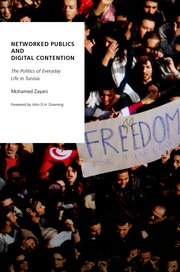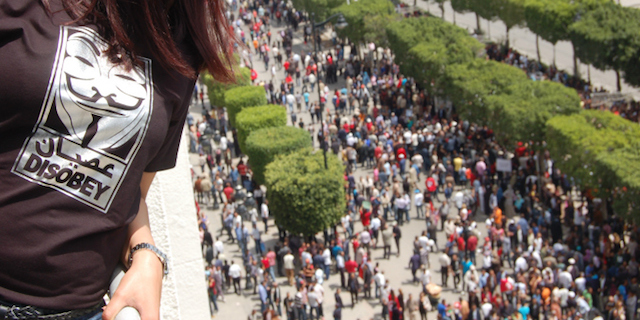Book Review: Networked Publics and Digital Contention: The Politics of Everyday Life in Tunisia by Mohamed Zayani
How has ‘the networked public’ contributed to the development of new social movements, strategies of resistance and an evolving relationship between the state and society in the realm of the everyday? In Networked Publics and Digital Contention: The Politics of Everyday Life in Tunisia, Mohamed Zayani takes Tunisia as a case study, drawing upon fieldwork, interviews and immersive analysis to show how social media is shaping the politics of everyday life following the ‘Arab Spring’. This book navigates a line between optimism and pessimism, acting as both a process of documentation and inspiration, writes Helton Levy.
Networked Publics and Digital Contention: The Politics of Everyday Life in Tunisia. Mohamed Zayani. Oxford University Press. 2015.
 Amongst all the paths to democracy, freedom of expression remains one of the hardest battles, which one can never completely win. Navigating through dense waves of blogs, fanzines, Facebook pages and other forms of online discussion, Mohamed Zayani explores the many attempts by media producers in Tunisia to forge a multi-angled and democratic conversation.
Amongst all the paths to democracy, freedom of expression remains one of the hardest battles, which one can never completely win. Navigating through dense waves of blogs, fanzines, Facebook pages and other forms of online discussion, Mohamed Zayani explores the many attempts by media producers in Tunisia to forge a multi-angled and democratic conversation.
Part of the so-called ‘Arab Spring’ revolutions, Tunisia has become a successful case of transition from a dictatorship to a non-authoritarian model of government. In Networked Publics and Digital Contention: The Politics of Everyday Life in Tunisia, Zayani does not relativise that momentum, but rather aims to acknowledge ‘the networked public’ as a structure-builder and as a long-term negotiator of plurality in the mediascape. He claims that over the years, ‘the Internet nurtured a silent opposition’. At the same time, we learn that ‘silence’ can hide a lot of dissent, which will later appear as other forms of citizens’ politics.
In 2010, the self-immolation of Mohamed Bouazizi confirmed how social networks, such as Facebook, could indeed play the role of facilitator in the age of ‘mediatised’ emotions. Zayani has nevertheless landed the tech-determinism airplane by also remembering the degree to which traditional media outlets such as Al Jazeera had influence with their more straightforward coverage. For him, their ‘conventional’ tone spoke much more to people’s hearts by transforming outrage into successful political awareness.
While disagreeing with Internet critics for their pessimism, Zayani grounds his case on the level of everyday ephemerality. He draws on Henri Lefebvre’s Sociology of the Everyday to debate whether the myth of the overnight digital revolution has lost some of its shine. This also dehydrates the idea of the ‘networked movement’ as a supernatural, leaderless phenomenon, which has been a recurrent idea in social movement studies. In the case of Tunisia, net optimism has faced a tough social reality, including extremely disillusioned, unemployed youth. There is no doubting that young Tunisians have reached for the Internet to show dissent and search for dialogue. Yet, between their urgency to break free and the appointment of the Internet as an abstract sponsor, it remains evident that in the heat of the protests, the Tunisians were the main source of power and disruption.

1st of May protest, Tunis, Tunisia. Credit: scossargilbert CC BY 2.0
Zayani accordingly resists putting things in such a simplistic manner. No evidence suggests that collective (or connective) digital action had led anyone to material acts. However, the networked public idea is instead useful for challenging the image of passivity from President Ben Ali’s time (1987-2011). We also learn to give more importance to daily media frames depicting dissent and suffering, which will inevitably influence public opinion. Yet, for that latent sense of injustice and outrage manifest as a result of multiple media frames, the public has to somehow want and push for explosive dissent and activism.
As we see, a Renaissance of voices in both Arabic and French has happened as the growing number of cyber activists revitalises both aesthetics and language, from the late 1990s activist group Takriz to the contemporary contestation of Tanzine. The actual format of these interventions does not come problematised as Zayani prefers to discuss their discourses. Some bloggers live in Tunisia, while other outlets, such as Tunisiens du Monde (Tunisians of the World), are products of the diaspora. Kissa Online practises ‘artful contention’ with lots of intertextual resources, such as satire and poetry. Although some visited blogs have not received new content since 2011, others seem to enjoy constant popularity, as it is the case of Kissa and Tunezine, Nawaat and Reveil Tunisien.
With this much variety, there is not much sense in only perceiving ‘discontents’ here. ‘Discontent’ may actually seem a limited, monolithic way of describing what turns out to be a colourful political performativity. With that said, the book shyly approaches other sectors of Tunisian society that could also be connected, creative and empowered, while not so ‘progressive’, such as that of religion. Whether ‘the networked public’ is a concept applied to non-elite layers of society remains a controversial point. In any case, the blogs herein presented seem keen at popularising, rather than centralising, the narrative.
The networked public must also count on further support to live up to expectations. The last part of the book addresses important concerns relating to Internet surveillance. Will the Tunisian government succumb to Internet control and monitoring? The potential for a new authoritarianism remains unclear. As Zayani asserts: ‘There is no substitute for a careful analysis about how ordinary people interact with structures of oppression’ (201). Consciously or not, Tunisians could still repeat repressive tactics that originally belonged to the French coloniser. That point makes the discussion on authoritarianism rather more complex, as no victim and oppressor comparisons easily apply. For instance, in the dictator-free Tunisia of January 2016, protests against unemployment in Kasserine ended up in a government-imposed curfew.
Moving forward, we remain in doubt as to how solid the bases against oppression are today. To what extent will future power-holders allow such vast and rich narratives to prosper? These questions certainly depend on the quality of institutions and their ability to find the right tone in a world shaken by terrorism and religious fanaticism. However, it should not be hard to realise that media producers are closer to allies than to destabilisers.
The ecology of similar movements, mixing Internet and political participation around the world, only increases. We have previously witnessed the Zapatistas in Mexico, the Passe Livre movement in Brazil and the anti-occupation media in Israel. While much of what we read about them is on inconclusive attempts at dialogues with wider society, these also hint at new ways to scholarly approach this enormous discursive capital without trivialising its imperatives. Only with this permanent effort of searching, grounding and legitimisation will networked publics finally emerge as new agenda conveyors and leave the shadow of mainstream politics. Far from presenting a utopia, Zayani succeeds in recording the Tunisian case as both documentation and inspiration for other possible realities.
—
This post originally appeared on the LSE Review of Books. It represents the views of the author and not those of Democratic Audit UK or the LSE. Please read our comments policy before posting.
—
Helton Levy is a journalist and PhD researcher at City University London. His research involves alternative media and inequality in Brazil. He is on Twitter: @heltonvlevy. Read more reviews by Helton Levy.





 Democratic Audit's core funding is provided by the Joseph Rowntree Charitable Trust. Additional funding is provided by the London School of Economics.
Democratic Audit's core funding is provided by the Joseph Rowntree Charitable Trust. Additional funding is provided by the London School of Economics.
#BookReview: Networked Publics and Digital Contention: The Politics of Everyday Life in Tunisia by Mohamed Zayani https://t.co/6Yq80zqO7b
Book Review: Networked Publics and Digital Contention: The Politics of Everyday Life in… https://t.co/PrxQGyzZ3i https://t.co/fwQenVQawW